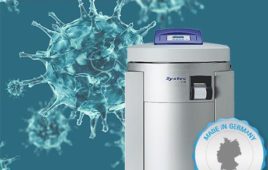Let me preface this article with an explanation of my approach to the simplification of contamination control cleaning SOPs (standard operating procedures) and their associated log books/sheets.
Developing and implementing Standing (yes, itís ìStanding,î not ìStandard;î most SOPs differ, making them non-standard) Operating Procedures, and forms to record the completion of a scheduled contamination control procedure, chemicals used, and completion time, etc. should be as ìhuman being proofî as possible.
We are in a very serious business. Potentially, the lives, health, and safety of thousands of people rely on our detailed, timely, and accurate application of contamination control procedures. Having said that, it is my hypothesis that rather than limiting or eliminating human error, intricate and cumbersome SOPs and logs serve as amplifiers of human error.
SOPs
SOP development needs to be as thorough as possible, but it should also be logical, straight forward, and easily amended. Although SOPs are frequently drafted and reviewed for changes and updates by the professional staff, they are seldom initially given for review by those actually tasked with carrying out the procedures. The old axiom ìNo plan survives contact with the enemy,î often applies to SOP development. The enemy here is the actual, sequential implementation of the procedure.
Having the freedom to develop and implement your own SOPs can be a double edged sword of which ìadherenceî is the sharper sideóyou wrote it, you better adhere to it. Remember, your SOP is the blueprint for appropriate, applicable, and accurate procedural performance, and should not be a straight jacket. Unless you are fond of writing, being overly detailed in procedural construction can be a pitfall. Detailed descriptions such as 9î x 9î wipes, 14î sponge mops, 36î x 36î tacky mats, and similar items can put you in a pickle if your supplies run out and your vendorís delivery truck is snowed in. More flexible terms should be employed such as, ìindustry or organizationally approvedî clean room wipes, mops, and tacky mats. Wording it in this manner provides your SOP with some operational breathing room. However, this simplification should not be applied to cleaning chemicals or their concentration or areas for use. Chemical information should be detailed.
Specifying exact times for contamination control cleaning can also have serious drawbacks. If the production, manufacturing, and research team works overtime or late, blocking the scheduled cleaning time, you have violated your own SOP by not having the cleaning done at the appointed time. The options here are: 1) stop production/manufacturing/ research so you can clean, resulting in losing time and money; 2) hope someone in authority is on site to write a deviation to avoid violating your SOP. These problems can be avoided by changing the verbiage to allow flexibility. Rather than a specific time, use words like: daily; weekly; monthly; changeover; and special cleaning, etc.
However, this approach does not eliminate the possibility of errors when the contamination control crew starts their work, as many do, at 11:00pm (2300hrs). The problem starts when a scheduled cleaning is for the calendar date the crew starts, but doesnít get performed, for whatever reason, until after midnight, the next calendar date; back to drafting deviations. Back-dating the cleaning to correct this problem is a data error entry and a serious violation of your SOP.
To remedy this, consider this scenario. On arrival at the site, the contamination control crew has to check their assignments, prepare fresh chemicals, gather equipment, and gown up before any cleaning gets started. Under the best of circumstances, that adds up to twenty or thirty minutes of prep time. If you have scheduled a large room needing a monthly cleaning for the calendar date the crew signs-in on, youíve created your own problem. Eleven to seven schedules work well in hospitals, but can present problems in clean room environments. Calculate the prep time and then schedule the staff earlier or later as needed.
Frequently additions, deletions, or changes are made to product lines and processes necessitating SOP changes. Just how difficult you want the change process to be is up to you. Developing a change/update approval list for each SOP and publishing that list will help facilitate the change process. The importance of knowing exactly who is impacted by the change, and needs to be involved in the process cannot be overstated. But also knowing who does not need to be involved is important to simplifying the change process. Example: you are not changing the type, concentration, or usage quantity of your chemical so why elongate your change approval process by routing the change through purchasing? Also, there should be considerable staff review and input when developing these change lists. Donít forget to involve a representative of the contamination control cleaning team.

Developing Log Book/Sheets
Keep in mind that every manual entry (for example 01/02/04 = 8 possible entry errors) could become a write-over because of a faulty pen, illegibility, or around January, for example, entering an incorrect year. Remember the human factor when developing your logs. Log book/sheet development should be based on accuracy, applicability, and simplicity.
Here are some tips in designing log books:
1. Restrict entries to that data your procedures dictate you MUST capture.
2. Make data entry blocks large enough for ìIn Boxî corrections. This eliminates most of that annoying group of footnote error explanations at the bottom of the sheet. Beware: these error explanations can also generate errors.
3. Eliminate ìcommentî lines on your sheets. A frequent error here is staffers writing ìNone,î which is an entry error. If there are no comments then the line is not used, necessitating a line through, initials, and date. Your in-box error corrections should be comment enough.
4. Institute an ìauthorized signature & initialsî page as the front page of your logs. This will match people to their initials and also aids in identifying unauthorized sign-offs on procedures and corrections.
5. Supervisor/Inspector initials on logs sheet can be highly misunderstood. Do the initials mean the super visor/inspector was physically present during the procedure or chemical preparation and is verifying its correct completion or preparation, or does it mean they were not present and are only verifying the data line log entry was done correctly? Unless your company is small enough, or have enough supervisors/inspectors to view every procedure or chemical preparation, stipulate that all supervisor initial entries are for verifying data entry correctness.
6. Simplify as many entries as possible. Example: If you rotate Chemical A, Chemical B, and Chemical C, pre-populate the data block with a CA, CB and CC so staffers only have to circle the correct chemical applied that day. Likewise, daily, weekly, monthly, changeover or special cleanings can be reduced to a D, W, M, C, S circle entries. Also drains, sinks, wall, ceiling and floors and equipment can be abbreviated. If youíve completed a triple wash down of an area, or a special cleaning, you can circle as many items as applicable.

See Tables 1 and 2 for ìLimitless Errorî and ìReduced Errorî samples.
Having passed this article through technical, and process oriented staff in my own organization for comment, concurrence, and criticism, I am acutely aware of the ìwhat ifs,î ìsuppose it,î and the ìbut thenî arguments this article will invoke. Those arguments are the reason we are authorized the deviation alternative. It is not my intent to violate any industry guidance on the development of SOPs, or log books/sheets. It is my intent to convince you that there is no industry guidance that mandates you make your processes and logs so intricate and difficult to complete, that you become your own worst enemy.



